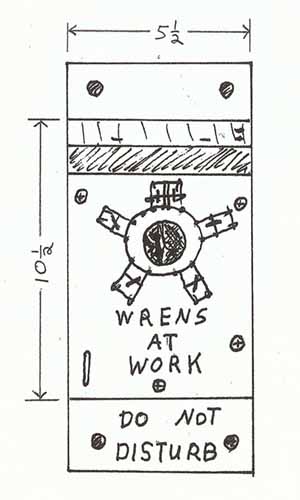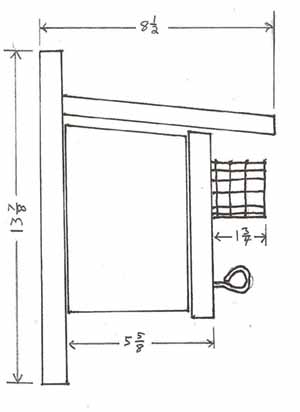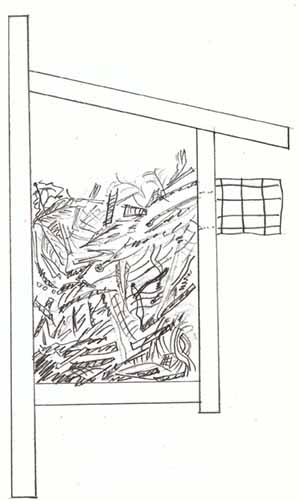Sometime during the spring migration of 2003 a fellow birder pointed out a House Wren nest near the Andrew Haswell Green bench in the north end of Central Park. It was inside the hollow branch of an otherwise healthy tree. The wrens entered and exited through the broken end of the approximately five foot long branch. There was a long crack running most of the length of the branch which might have helped with drainage and/ or ventilation, but was otherwise too small to allow the birds to pass. Its location on the downhill side of the tree, away from the footpath and protruding nearly into the lower shrubbery made it an ideal site. It was well shaded by the tree’s canopy and the tree combined with the shrubs to create good concealment. I observed the wrens on a nearly weekly basis during the 2003 and 2004 nesting seasons; both seasons were successful. I didn’t keep notes or count things like eggs or fledglings, but I did observe food being ferried into the nest, fecal sac disposal, and ultimately, fledgling wrens. I also spent some time in the pure enjoyment of the wrens’ defense of the nest. Their song is as beautiful as it is relentless.
Some time in the late-summer or fall of 2004 the branch was severed from the tree. It was left to rot where it still lies at the base of the shrubbery, just downhill from the tree. Upon discovering this I was both crestfallen and angered. I couldn’t fathom the reason for the destruction of the nest. Neither could I let the event pass without an attempt at remedy. A man-made nest box would have to take the place of the natural cavity and I was just the guy who could make it.
Getting permission to install a nest box proved much more difficult than making one. I called every agency I could think of that might be able to grant approval. The answers I received ranged from comical to transparently false. No one was able or willing to even give me the name of the person with whom I should discuss the project and plead my caser I heard: “The identity of that person is private and not available to the public”; “We don’t put bird houses in the park”; “If you get caught putting up a nest box you will be charged with vandalism”; and my personal favorite, “Wrens are destructive. You should not do anything to help them.” Needless to say, I began what some of my friends called “Ninja” nest box activity.

In an effort to keep my efforts as righteous as possible, I dug through some material from the Cornell Laboratory of Ornithology. There were plans for nest boxes for many species in one of their bulletins. I adopted a design and tried to execute it down to the type of wood to be used. Plain, unfinished cedar or redwood is best for two reasons. First, it contains oils which make it more weatherproof and durable. Pine might last several years, but cedar or redwood should last over a decade. Second, those same oils are repellent to many kinds of insect. Instead of trying to find some neem to place in the box to deter bugs, I used cedar to make it.
It was also necessary for me to consider how the box might be mounted. Part of the pitch I was hoping to deliver to the powers that control such installations included a permanent post on the same side of the tree as the original branch. As time passed, it became clear I would not even get to speak with a Parks Department employee or someone from the Central Park Conservancy, let alone get permission to install a nest box. That left the tree as the only possibility. Nails, screws, and any other fastener which might penetrate the tree were out of the question. So was any kind of thin, sharp wire or cord for the same reason. I finally settled on many strands of jute twine. The color blended better with the tree and several strands spread the load of the box over a wider area than a single strand of rope. No harm would come to the tree over the four or five months the box would be in place – I planned to remove it for cleaning and sterilization in the fall.
But first, I had to get the box into the tree and not get myself into trouble. I asked friends to keep an eye out for House Wrens in the park and tell me when they had arrived. I felt the timing was critical. If the box were found too early it would be removed before the wrens moved in. If it was too late, the wrens might relocate and not inhabit the box. However, if the nest box were discovered after the wrens had occupied it and were in the process of building a nest, not even the most callous gardener would disturb it until after the young had fledged. Or, so I hoped, anyway.
In the pre-dawn darkness of late-April, 2005 I managed to find my way to the tree. I can’t say it was a walk in the park. I felt as if my intentions were being broadcast to every person I passed. The only ones who concerned me were the police in their scooters. I have to say, I got lucky. I tied the box to the tree, put all the extra twine and the plastic bag into my backpack and donned my binoculars. I walked toward the south looking every bit the part of the average birder. I hadn’t walked more than twenty steps when the back end of a police scooter came into view. It had been parked there on the south side of the hill for some time, but it was facing the wrong way and the cop was reading something by artificial light. I strode past as though I hadn’t any clue about the crime which had just taken place on the other side of the hill.

The wrens were lucky that year. Two days later I found them ferrying nest material into the box. It stayed unmolested until I retrieved it in the fall. That wasn’t the case in 2006. The box was left alone for the breeding season, but disappeared before I could retrieve it. I put a new box up too early in 2007. It too was taken. I put up another and, through a friend, managed to get some assurance from the zone gardener that it would stay until I retrieved it that fall. It did. I did. And this box is the subject of this article.
Except for three changes, the box is the same as the one described in the Cornell plan. First, I used deck screws to secure the parts – Cornell suggests galvanized nails, but screws are much stronger as well as much less subject to corrosion. Second, I was forced to use another wood – I ran out of cedar and didn’t have the funds for more. I did have some poplar. Considering the probability of the box being removed, I used the less desirable material. Third, I added a Noel guard – this is the tubular cage over the entrance. It is made of galvanized half-inch screen and has proven quite durable and effective. The defense it offers against predators seems well worth its unsightly appearance. Anyway, the wrens do not seem to mind.
House Wrens fill their nest cavity with a variety of materials and in a very intelligent way. When I examined the box after the nesting season, it appeared as if the entrance was blocked by nest material. All you can see is a wall of twigs and feathers. Only by looking at the top of the actual nest interior can you discover the wrens’ little secret. Immediately upon entering the nest box the wren must make a sharp right turn and work its way along the inner wall toward the rear of the nest to get to the depressed area which contains the eggs or nestlings. Obviously, intelligence was used to design this wall of secrecy into the nest, but I never suspected such duplicity from such a small and arrogant bird.
Perhaps I mistake arrogance for simple pride of accomplishment. The materials used in the construction aren’t unusual, but the size of some of them is. There are twigs four to six inches in length and the largest is about 5/32 inch in diameter. That isn’t much of a twig for us humans, but in wren equivalents, it’s as if one of us carried a small tree trunk up five or six flights of stairs, pushed it through a tunnel, then jumped down several flights inside a house to arrange the log in a useful way, then do it over and over until the entire house is filled to the point that only two or three of us can sit in the attic. If I could achieve anything close to that spectacular feat, I would be filled with pride to the point of arrogance, too.

Of course, the wrens use smaller materials, too. There were a few long flat fibers, some dried grass and a few conifer needles.
The finest of the twigs used varied from an inch to four inches in length but only about 1/16 inch in diameter, making them flexible and capable of being woven between the thicker sticks. The only man-made material used in the construction of the nest was a well-worn and weathered piece of magnetic recording tape. Most of the magnetic oxide had come off, but the long, thin plastic material was used to weave together some of the upper portion of the nest filler just beneath the depressed cup where the eggs were laid. There were also some remnant strands of the twine I used to tie the nest box to the tree. I scattered some below the nest and put a few inside just in case they might be useful. It appears they were. These fine fibers look to be what the nest cup was made from, but the wrens had to unravel each strand and haul it inside before weaving the cup.
The nest also contained quite a collection of feathers. They came from Red-bellied Woodpecker, Blue Jay, House Wren, European Starling, and probably House Sparrow . There might also be species represented I was unable to identify. These feathers were woven through the coarser material similar to the thinner twigs, with the smaller feathers closer to the top of the nest.
Generally, these materials trended from coarse and thick to fine and flexible as the nest was laid from bottom to top. Some of the longer “logs” were set at an angle in the cavity while the finer materials were used to lock things in place. Feathers and the plastic recording tape were woven in a way that held things quite securely. The entire interior structure came out of the box as a unit. It took some considerable teasing and prodding to separate the individual pieces without causing any damage, especially at the top where down feathers, plant fiber, and flat grass segments were formed into a mat to support the fine fiber cup. Feces also held some elements of the upper structure in place. This may have been intentional or could have just been the result of young birds doing what young birds do.
Every tale has its villain. I suspect the insect remains found in the nest material might fulfill that purpose here. There were what appeared to be three species of “bug. Even four times magnification was no help to me in identifying these exoskeletons. I can’t even be sure when these creatures entered the nest. The box was in my possession from late fall of 2008, but I didn’t study the contents until April of 2009. I suspect they may be some kind of parasite, but only make that guess based upon their general appearance and that they were in the nest material. I can’t imagine an insect beneficial to House Wrens which isn’t part of their diet.
Fortunately, this story does have a happy ending. In conversation with Regina Alvarez of the Central Park Conservancy concerning the repair of yet another nest box located in the west end of the wildflower meadow, I learned of plans for a permanent nest box installation at the Green Bench location. I saw it in place, with House Wren loudly singing nearby, on April 27, 2009. Now I can put my Ninja costume away and express my sincere thanks to her for giving me official permission for the wren nest box. I couldn’t be happier and I’m sure the wrens will make good use of the new digs.

